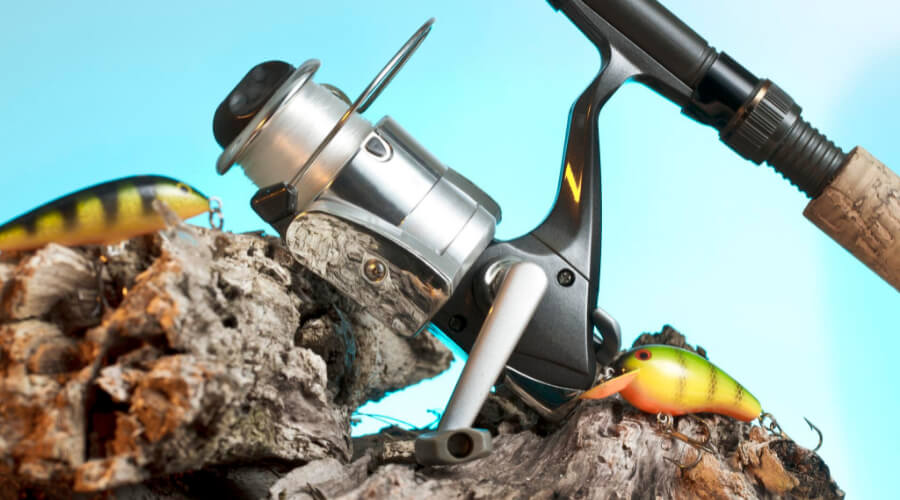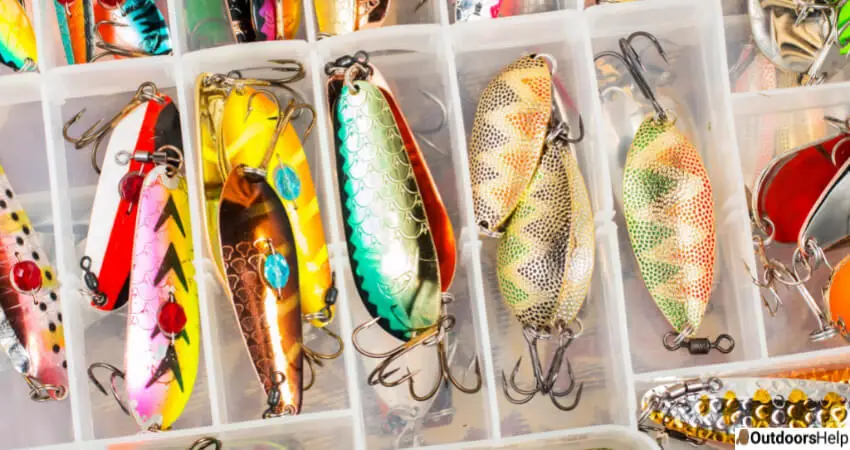As a beginner angler, you’ve probably heard about the red devil lure and how well it works. Apart from being popular for its excellent performance, the lure also has some fascinating history. Are you curious to find out where the name originated? Is the lure worth the hype? Please stick with us to learn more about this staple in everyone’s tackle box.
A red devil fishing lure is an all-around spoon lure that is mostly red with a white stripe and has a devil head image on the white line. It’s excellent for game fish like bass, pike, muskie, and walleye.
This is the most durable and reliable lure you will ever come across. Whether you are trolling or casting, this spoon will always sport a unique action that’s irresistible to game fish.
History Of The Red Devil Lure

The red devil lure has been in the market for over a century and is a staple among anglers. It is a narrow and spoon-shaped metal with a hole for your line on one end and a hook on the other. They come in a variety of colors, but the most popular color is red and white. These lures are manufactured by Eppinger manufacturing and have quite a fascinating history and story behind the name.
How The Company Started:
Lou J Eppinger started Eppinger Manufacturing. He was born in 1877 in Detroit and started as an apprentice at a shop called Taxidermy. And when the owner died, He inherited the business and renamed it Eppinger taxidermy studio. This business was seasonal, and Eppinger wanted to increase his yearly income, so he started selling fishing tackle in 1910. During that time, fishing was popular as both a hobby and a means of putting food on the table. This made his business grow, and he became a full-service outdoor sporting goods outfitter.
Making Of The First ‘Red Devil’ Fishing Lure:
During that time, it was almost impossible to find a lure that would cast a distance without causing backlash, and Eppinger set out to make one. He began experimenting and making lures out of metal, aiming to incorporate swimming action into the design. He kept reshaping and tweaking his creation, and after seven years, he was satisfied with what he had made. He started working on the final touches of an oblong-shaped spoon that cast well and was easy to control. This spoon also stood up quite well to pike fishing and was made of copper with a thick middle and thin edges.
The lure that Eppinger had designed made its debut in his shop in early 1918. He named it Osprey after the bird, which he believed to be the “best fisher ever created.” The lure was first made in black and white and became popular through word-of-mouth advertising. Eppinger added other colors such as frog green, nickel, and red and white which is recognized to date.
After world war 1, Eppinger decided to change the lure’s name from Osprey to daredevil. He did this to honor the US marine corps who fought at Belleau Wood and captured German soldiers. It is said that the German corps started referring to the US corps as ‘Teufel hunden’ like the legendary daredevil dogs of northern Germany. This is where the term daredevil was derived and started being used commonly in the forces. Eppinger changed the spelling to dardevle for the sake of anyone who would get offended by the word “devil’ being printed on the product.
Marketing And Growth Of Eppinger Manufacturing:
Eppinger’s ultimate goal was to have a dardevle in every angler’s tackle box, and he focused on the lure’s quality craftsmanship. With veterans coming back from war with money and lots of time to spare, the time to make enormous sales was playing out well. Eppinger invested in marketing by buying ad space on a magazine and working with outdoor writers to publicize the lure. All this time, manufacturing was still going on in the basement of his shop. He also created a lodge on the second floor of his shop where outdoor lovers would meet and discuss everything outdoors. The dardevle lure was affordable, and people from all walks of life could get it.
Over the years, Eppinger introduced new lures then left the business under the leadership of his nephew. Lou j Eppinger passed on in 1958, and Ed became the company’s president. The new president decided to focus entirely on lure manufacturing and worked on expanding colors and combinations. Ed was a savvy marketer who took the brand worldwide; he made fishing trips to various countries and carried writers with him. He also made short films to advertise the lure by getting young people to watch the movies and get interested in fishing.
Challenges And Weathering The Storm:
It was not all rosy for Eppinger manufacturers through their journey in business. After world war II, Japanese manufacturers started making cheap imitations of the lure. The replicas were of low quality and did not pay attention to details like the original. Eppinger had to begin printing a devil head logo on their spoons with the name dardevle at the back to counteract those fakes. In the 1960s, salmon were introduced to the great lakes, which gave dardevle a significant boost in sales.
With the growing popularity among anglers worldwide, the name dardevle became a source of interesting discussions. In some regions, the name is pronounced literally, while in places like Canada, the lure is still referred to as the red devil. Ed Eppinger passed on in 1987 and left the business under his daughter Karen and other directors who still run the company to date.
Eppinger manufacturing has countless dardevle models in different combinations, colors, and sizes. You can find them in the classic red and white, fluorescent and glow in the dark colors, saltwater models, and weedless lures. As you know it, the dardevle, or red devil, is a favorite for many and has played a role in creating epic fishing memories.
Is The ‘Red devil’ Lure Worth The Hype?

Now that you know how this popular lure came to be and the growth process of Eppinger manufacturing, let’s give you an honest review of the lure. But before we do, here are some of the features and specifications of this lure that you might need to know.
Features:
1. They cast a distance accurately, thus covering a lot of water.
2. Spoons don’t run too shallow or too deep when fished correctly.
3. They are easy to use since you don’t have to calculate their dive rate or know how to use them.
4. Red devil spoons are versatile and can be cast into shallow rocks without getting snagged.
5. They are easy on fish making them ideal for catch and release.
6. Spoons are hardy and can stand up to the violence of big pike.
7. These lures are available in a variety of sizes and colors to target different species and fishing situations.
Specifications
| Available categories | Pike, bass, salmon/trout, and walleye lures |
| colors | Black and white, green and white, green and red, nickel, black with silver, and over 100 color combinations |
| Weight | Ranges from ½ oz to 31/4 oz depending on size |
| dimensions | Available in different lengths and thicknesses depending on target species |
Verdict: The red devil or dardevle lures are worth the hype. If you love quality and functionality all in one lure, you can’t go wrong with the dardevle. You only need to ensure you get an original and not the knock-offs that have flooded the market currently.
We hope that this article was enlightening, and you can now confidently join the bandwagon of happy anglers who use this lure. Spice up your tackle box with one and enjoy your adventures.

